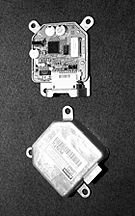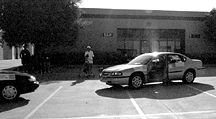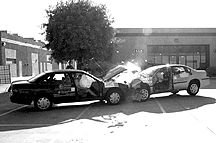In some cases ACRs resort to using even less reliable data: eyewitness accounts. These are often recorded months later and thereby suffer from the fog of time. Further, one or more of the parties may be involved in a lawsuit over the crash, and is likely to be influenced by this fact. As most collisions are due to driver inattentiveness, not even taking into account the potential for legal bias, the observations of at least one of the witnesses is likely to be very unreliable.
From these data, ACRs make calculations using vehicle dynamics equations to arrive at crash speeds. Then, using appropriate equations, such as the law of conservation of linear momentum, or angular momentum, etc., we can estimate velocity changes and accelerations. In low- speed crashes, these methods are fairly crude, as I have noted in several previous articles. Once we've done those estimations, we can only make deductive estimates of the pre-crash conditions, such as braking, throttle control and seat belt use. And, of course, there is the important question of occupant kinematics and human risk factors.
Since about the early part of the last decade, some auto manufacturers have been installing black boxes in passenger cars. The primary purpose of such devices has been to manage airbag deployment, but the boxes have become increasingly more "intelligent," allowing us to download data and analyze it. For manufacturers, this is a boon, since there are about 18,000 tow-away crashes in this country every year. Real-world crash data is invaluable in the pursuit of the highest achievable crashworthiness. Crash tests of cars into fixed barriers - the only type that have been feasible for manufacturers in the past - cannot effectively answer many of the questions researchers have about the very complex and varied crashes that happen between different crash partners (the relationship of autos in a collision with each other), trucks, and fixed objects every day.

Figure 1: SDMs from two typical late-model GM vehicles. These are generally mounted under the seat, dashboard, or center console. |
In Europe, several papers have already been published on the results of analysis of small datasets of real-world crashes in which on-board crash pulse recorders (CPR) have allowed researchers to measure delta V and acceleration of the crashed vehicles.
General Motors began installing the sensing diagnostic module (SDM) in its passenger fleet in 1990 (see Figure 1); Ford began installing it in 1997. It is installed over the transmission hump (under the console), under the dashboard, or under the seat. The SDM detects accelerations and makes split-second decisions for deployment (of airbags) and nondeployment events. It tracks acceleration (and in the case of a frontal crash, this is negative acceleration or deceleration) in discrete time packets every 10 msec., and based on the slope of the acceleration-time curve, determines whether a deployment will be necessary. Most importantly, it does this fast enough to allow for a rapid enough deployment to save a life.
In addition to its primary function of airbag management, the SDM tracks data on pre-deployment braking; engine speed; vehicle speed; percent throttle; seat belt use; and also records crash data. This can be retrieved from the event data recorder (EDR), which is part of the SDM. In fact, one manufacturer in Santa Barbara, California now sells hardware and software that can access these systems and analyze the data. This is greatly enhancing the field of ACR for those who can afford it. Law enforcement and insurance agencies are also starting to use it. In Figure 2, the device used by GM to download this data from its modules is illustrated.
We recently put the EDR/SDM in late- model GM cars to the test at San Diego's CRASH 2001, a program sponsored jointly by the Spine Research Institute of San Diego and the Center for Research into Automotive Safety and Health (CRASH). Our efforts were backed by Texas A&M University and General Motors, which donated a 2000 Chevrolet Impala, along with support staff and the hardware/software needed for downloading and analyzing the black box data. Although I will report the results of our study in another paper, and the black box validation project was only one of several we were working on, I can report here that the GM car, with the EDR/SDM on board, performed precisely as designed, deploying the GM car's airbag with perfect timing. Perhaps as evidence of that, the head resultant acceleration of the Impala's volunteer occupant was about 40g, while that of the passenger of the opposing Ford Taurus was about 50g.

Figure 3: The approach path of the two airbag crash test vehicles with three volunteers. The Ford Taurus (left) is traveling at about 26 mph; the Impala is traveling at 18 mph. |
Figure 3 shows the cars just moments before impact. A human subject drove the Impala. A convertible infant carrier containing a child dummy was placed in the airbag-equipped passenger seat next to him. This was done so that on-board cameras could record the violent consequences of improperly placing the infant carrier in front of an airbag module. The Impala's crash partner was a 1994 Ford Taurus, provided by SRISD, which had approximately equal mass. It was driven by another human subject volunteer and had a third volunteer riding in the passenger seat. Although the planned approach speeds for both vehicles was 18 mph, the Ford's final approach speed in the test was 26 mph, giving a combined speed of 44 mph and a delta V for the Impala of 24 mph. All four airbags deployed properly at impact. Although the passenger volunteer in the Ford was initially shaken up, and complained of discomfort over the sternum where the shoulder harness made contact with the uniaxial accelerometer fastened there, no injuries occurred. In Figure 4 we see the approximate point of maximal engagement and, in Figure 5, the aftermath.
It seems likely that with time these recording devices will become more capable, with greater storage capacity and greater bandwidth, and there will be fewer unresolved questions about pre-crash and crash conditions. However, this data can be misinterpreted, and we can expect some conflict to continue between the two parties of a lawsuit. For example, the EDR requires a threshold event (acceleration) to begin recording a crash. In low-speed crashes this results in a slight inaccuracy - acceleration is underestimated. This margin of error is less important in higher speed crashes, of course. And, it goes without saying that knowing the occupant's response to those crash conditions will still require a strong foundation in occupant crash kinematics, human biomechanics, and motor vehicle crash traumatology.
Arthur Croft,DC,MS,FACO,FACFE
Director, Spine Research Institute of San Diego
San Diego, California
Click here for previous articles by Arthur Croft, DC, MS, MPH, FACO.








